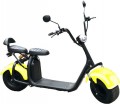Max speed
The highest speed that a vehicle can reach.
When choosing according to this parameter, it is worth considering that in dense city traffic, it is rarely possible to accelerate faster than 40 km/h; so if the vehicle is bought mainly for a comfortable ride through traffic jams, then there is no need to look for a high-speed model. In addition, for the same motor power, low speed means more torque, which makes it easier to climb hills.
Max. climb angle
The maximum incline that the vehicle can overcome.
Most vehicles, even the most inexpensive ones, can cope with angles of 10 – 12 ° without problems. So you should pay special attention to this parameter only if you have to deal with very steep slopes.
It is also worth mentioning that on road signs the angle of elevation is usually indicated not in degrees, but as a percentage. This means that to evaluate the capabilities of a particular unit, it may be necessary to convert degrees to percentages or vice versa. For this, there are special tables and calculators.
Clearance
Vehicle clearance.
Clearance is the distance from the ground to the lowest point of the vehicle (excluding wheels). Roughly speaking, this is the highest height of an object that can fit under the vehicle without being hit the body.
The higher the clearance — the higher the obstacles that the unit can cope with, the lower the likelihood that when overcoming another pothole or bump, the body will touch the ground. On the other hand, low ground clearance lowers the centre of gravity and improves overall stability; so for roads with high-quality pavement and other flat surfaces, it is the smaller clearance that is considered optimal.
Power
The motor power of a vehicle, in horsepower.
In general, the power of electric motors is indicated in watts. However, in electric transport, this designation is also often indicated. This is done for the convenience of comparison with internal combustion engines: for internal combustion engines, especially in vehicles, horsepower is traditionally used, and it is more convenient for some users to evaluate the power of motors by this designation. At the same time, if the need arises, some units are easily converted to others: 1 hp. ≈ 735 W.
For the power value in general, see the relevant paragraph below.
Full charge time
The time needed to charge the vehicle battery from 0 to 100%.
This parameter allows you to estimate what breaks you will have to take between trips to charge the vehicle. But keep in mind that a short charging time may mean a low battery capacity.
Separately, we note that in modern battery technology, “emergency” charging technologies can be used, which make it possible to partially replenish the energy supply in a very short time — for example, to charge a battery by 40% in an hour, which in normal mode would be fully charged in 8 hours.
Removable battery
The presence of
a removable battery allows you to replace it with a more capacious one. This option also allows you to change one for another on the road, thereby increasing the range.
Weight
The total weight of the vehicle without cargo and rider.
The
lighter the unit, the greater the range and, accordingly, the weight of the payload that can be carried on it. On the other hand, too little weight adversely affects the stability, and sometimes the overall strength of the structure.

